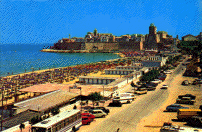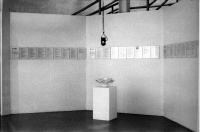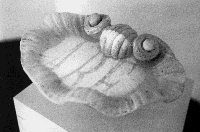// Alba D'Urbano
//

Main;
Projects() {
Esposizione Impraticabile();
Mare() {
}
The Negated Room();
Hautnah();
Touch Me;
Stoffwechsel;
Il Sarto Immortale();
Die Wunderschöne Wunde;
Tra cielo e terra;
L'età dell'oro();
Venere;
Private Property();
Monitoraggio;
corpo_insegnante();
Natura Morta(); Redden/Erröten; Son_no;
Airbag;
Collaborations();
Net-Works();
History();
Imprint;
Mare() {
The Installation;
} //1993
The idea of "Mare" arose out of an invitation to an international exhibition of contemporary art in Termoli. The title of the exhibition was "Talatta, Talatta" (ocean, ocean) from the Anabasis of Xenephon. I wanted to create a project which dials with the town itself : Termoli, a small town on the Adriatic-coast. The exhibiting gallery was a deconsecrated church situated on a hill on the outskirts of the old city. The front of the churchyard enables a view of the city from a special angle. One sees a part of landscape, which I discovered after further search, seems to iconographically repeat itself in the city. This portrait of the landscape was pictured on old etchings, postcards, souvenirs and oil paintings. This motif could be possible seen in an old fresco that was visual under the the roof of the same church that offered and showed a landscape containing sea and fish. I began working with this image.

The original idea was to install an interactive video-installation. A video-
camera fixed to the fassade of the church could be controlled by the visitor
in the exhibition. In this way it would have been possible to explore the
panorama, which changes into a typical bathing-scene every summer, up to the
horizon. The camera could form a bridge between two different realities, between
inside and outside, as well as art and daily routine.
The final realisation of the installation "Mare" projects two kinds
of video-sequences together: pictures of the original surroundings from the
front of the church and a computer-animation. The computer-animation stems
from a postcard of this landscape. The structuring 3 elements, sky, earth
and sea are transformed into their digital equivalent upto the point in which
the synthetic water covers the entire reality to reveal the ocean of symbols.
The installation was placed in the apsis of the church. A small lamplike video-
projector hung from the ceiling, projected both imageworlds together into
a shellshaped basin of holy water that was filled with water from the sea.
The images appear partly layered on the water and partly on the base of the
shell like a sort of vision. The images of reality were joined by the images
of the computer-animation for a
brief moment.


Hung on the three walls framing the heathen altar were three pieces of art
that worked with the word "Mare". The picture of the word that had
been generated via wordprocessing was deformed in three ways by the computer.
The symbols used by the computer to generate its graphics and the computercommands
to the plotter were printed as an ASCII-text.
At the end of all transformations there are nine pages of symbols created
for every word. A long incomprehensible digital poem that was nevertheless
the same as the sea of symbols at the end of the video, projected within the
shell as a layering of reality with its model and only conceivable and meaningful
to human interface.

For the sound of the video I used a text from the book 'Dialogues with Leucò' by Cesare Pavese in the italian language with the title 'Sea Foam', a dialoge with the greek poet Sappho and the nymph Britomart, which is shown on the following pages (Eridanos Press, Boston 1989, translated by William Arrowsmith and D.S. Carne-Ross).
(Frankfurt 1993)